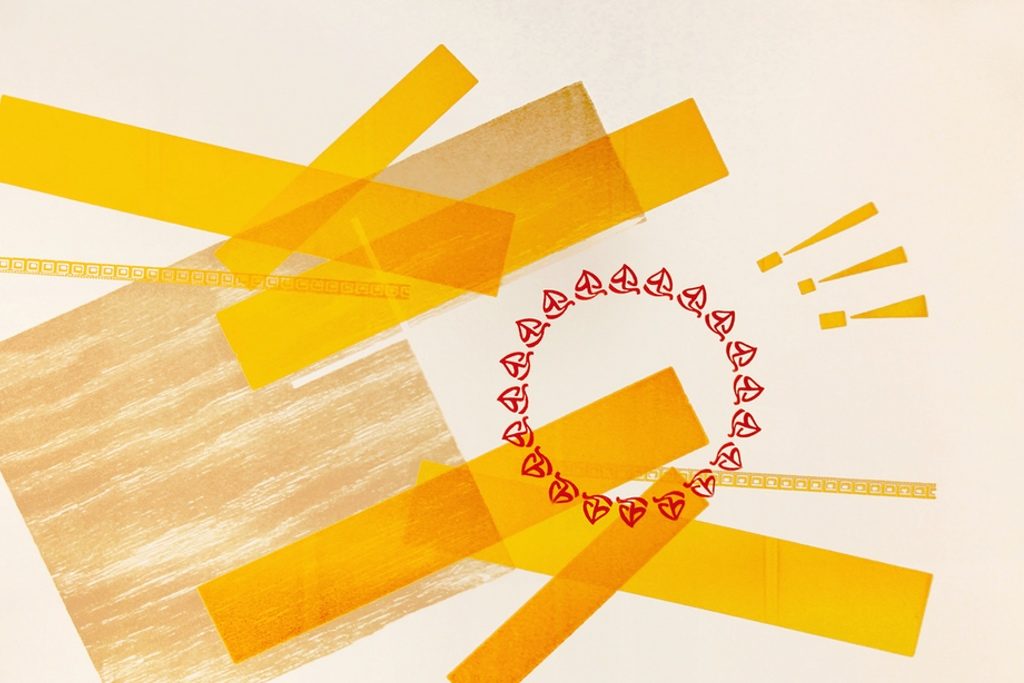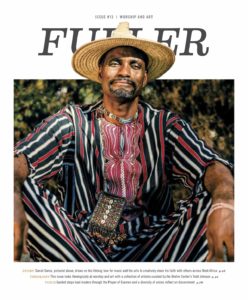
When I was a student at Fuller many years ago, a friend and fellow student took me one day on a tour of five California missions. On the broadest level, we could see that these complex, even controversial expressions of California history held a great deal in common. What my friend enabled me to see, however, was that beyond the superficial similarities were subtle and profound differences that reflected the distinct story of each tribe and location. The gospel was similar and different in each place. It was a lesson in paying attention.
Living as a disciple of Jesus requires paying attention in God’s name—to God, to our neighbor, and to our world. We exercise and express our attentiveness in countless and varied ways, and undergirding it all is the pervasiveness of God’s own faithful attention. The God “who never slumbers and sleeps” attends with unflinching truth, mercy, and justice. Human beings have been created in God’s image to manifest God’s attentive care.
We do this as finite creatures, of course: the only way any of us can do so. Our limits and liabilities affect our capacities. Human beings are only ever localized and fallen beings. Technology can make us feel a bit like we are multi-present, but we are in the end only “here.” Yet we are made in God’s image, with an ability to remember and to imagine, to rehearse and to anticipate, to live in only one place but to attach to what may be happening thousands of miles away. We analyze and synthesize. We see, but we see through a glass darkly.
Specialist observers come in many forms. Parents are chief among these, on whose attentive care our survival depends. So too are friends, who see and hear us with uncommon gaze and compassion. Teachers bring their attention to their discipline in order to pass that along to their students. Scientists observe, note, and probe to discover through their trained attentiveness what and how our world is.
Artists and artistry reframe and intensify our attention. The province of the artist is peculiarly and remarkably to pay attention. What Mozart and Coltrane, or Michelangelo and Banksy have in common is that they are acutely attentive. How they see, what they see, and how they help the rest of us to see, feel, recognize, and understand are critically important. Strangely, artists and art are sometimes perceived by people as discretionary. In fact, they are essential to our collective attention since at their best they will enhance, intensify, and pixilate what life manifests and to what we must respond.
We could not and would not be able to know our neighbor, ourselves, or the world around us without music, movement, visuals arts, and language. These are the effluences of thought and emotion that refract and embody what we perceive. Our artists pay obsessive attention to the visible and invisible. Their creativity speaks about what is apparent and inaccessible, about subtleties and voids. This is their passion and their burden. The arts show us we are human and depict our agency and impotence, our beauty and horror. We must have artists. And we also must have scientists, and mathematicians, and analysts, and parents and friends, politicians and pollsters, along with plumbers and launderers, fruit pickers and cooks.
It has often been said that we become like that which absorbs our attention most. By this measure, the current crisis of the evangelical church in America is what it reveals about what fixates our attention. Rather than revealing that evangelicals look like the life and love of Jesus, polls and actions reveal that we look more like the idols of power, race, fear, and security that dominate US culture. Disciples are meant to attend to the world through the lens of Jesus Christ. We are to see through the faithfulness, honesty, and courage of God to our vulnerable, beautiful, and suffering world, so that we may respond to and serve in love what has been entrusted to us. How we see is to affect who we see. Who we see reveals who and what we worship. To whom and to what are we paying attention and why?

Cuando era estudiante en Fuller hace muchos años, un amigo y compañero de estudios me llevó un día a un recorrido por cinco misiones de California. En general, pudimos ver que estas edificaciones, incluso expresiones controversiales de la historia de California tenían mucho en común. Lo que mi amigo me permitió ver, sin embargo, fue que más allá de las similitudes superficiales había diferencias sutiles y profundas que reflejaban la historia distinta de cada tribu y lugar. El evangelio era similar y diferente en cada lugar. Fue una lección en cuanto a prestar atención.
Vivir como discípulo de Jesús requiere prestar atención en representación de Dios: a Dios, a nuestro prójimo y a nuestro mundo. Ejercemos y expresamos nuestra atención de maneras innumerables y variadas, y en el fondo de todo esto está la omnipresente y fiel atención de Dios. El Dios “que nunca duerme ni se adormece” atiende con verdad inquebrantable, misericordia y justicia. Los seres humanos han sido creados a la imagen de Dios para manifestar el cuidado atento de Dios.
Lo hacemos como criaturas finitas, por supuesto: esa es la única forma en que cualquiera de nosotros puede hacerlo. Nuestros límites y responsabilidades afectan nuestras capacidades. Los seres humanos son seres siempre localizados y caídos. La tecnología puede hacernos sentir un poco como si estuviéramos presentes en varios lugares y ocasiones, pero al final solo estamos “aquí”. Sin embargo, estamos hechos a imagen de Dios con la capacidad de recordar e imaginar, ensayar y anticipar, vivir en solo un lugar, pero para participar en lo que puede estar sucediendo a cientos de kilometros de distancia. Analizamos y sintetizamos. Vemos, pero vemos a través de un cristal oscuro.
Los observadores especializados vienen en muchas formas. Los padres son los principales entre ellos, de cuyo cuidado atento depende nuestra supervivencia. También lo son los amigos, que nos ven y nos escuchan con una mirada y compasión poco comunes. Los maestros prestan atención a la disciplina para poder transmitirla a sus alumnos. Los científicos observan, anotan y prueban para descubrir a través de su atención entrenada el qué y cómo de nuestro mundo.
Los artistas y el arte replantean e intensifican nuestra atención. La meta del artista es peculiar y notablemente el prestar atención. Lo que Mozart y Coltrane, o Miguel Ángel y Banksy tienen en común es que son sumamente atentos. La forma en que ven, lo que ven y la forma en que nos ayudan a ver, sentir, reconocer y comprender al resto de nosotros son de importancia crítica. Extrañamente, los artistas y el arte a veces son percibidos por las personas como discrecionales. De hecho, son esenciales para nuestra atención colectiva, ya que, en el mejor de los casos, mejorarán, intensificarán y pixelearán lo que la vida dice y a lo que debemos de responder.
No podríamos conocer a nuestro prójimo, a nosotros mismos o al mundo que nos rodea sin música, movimiento, artes visuales y lenguaje. Estos son los efluentes del pensamiento y la emoción que refractan y encarnan lo que percibimos. Nuestros artistas prestan atención obsesiva a lo visible e invisible. Su creatividad habla de lo que es aparente e inaccesible, de sutilezas y vacíos. Esta es su pasión y su carga. Las artes nos muestran que somos humanos y representamos nuestra agencia e impotencia, nuestra belleza y horror. Debemos tener artistas. Y también debemos tener científicos, matemáticos, analistas, padres y amigos, políticos y encuestadores, junto con plomeros y lavadores, recolectores de frutas y cocineros.
Se ha dicho a menudo que nos convertimos en lo que más absorbe nuestra atención. Según esta medida, la crisis actual de la iglesia evangélica en América es lo que revela aquello en lo que fija su atención. En lugar de revelar que los evangélicos reflejan la vida y el amor de Jesús, las encuestas y las acciones revelan que nos parecemos más a los ídolos del poder, la raza, el miedo y la seguridad que dominan la cultura de los Estados Unidos. Las y los discípulos están destinados a servir al mundo a través de la lente de Jesucristo. Debemos ver a través de la fidelidad, la honestidad y el valor de Dios para con nuestro mundo vulnerable, hermoso y sufriente, para que podamos responder y servir con amor aquello que nos ha sido confiado. Lo que vemos afecta a quien vemos. Lo que vemos revela a quién y qué adoramos. ¿A quién y a qué prestamos atención y por qué?

수년전제가풀러의학생이었을때저의친구이자 동료였던 학생이 어느날 저를 캘리포니아의 다섯 개 선교 투어로 데려갔습니다. 거기에서 우리는 캘리포니아 역사에 대한 복잡하고 심지어 논란의 여지가있는문제의표출들이가장큰수준에서보면 많은 공통점을 가지고 있음을 보았습니다. 그런데 그 친구는 그런 피상적인 유사점들을 초월하여 각 부족과 그들의 지역이 가지고 있는 독특한 이야기가 반영되는 미묘하고 심오한 차이점들을 이해하도록 도와주었습니다. 복음은 각 지역마다 비슷했지만 또한 다르기도 했습니다. 이 경험은 저에게 관심을 갖는다는 것이 무엇인지 배우는 레슨이 되었습니다.
예수님의 제자로 산다는 것은 하나님과 이웃, 그리고 우리가 살고 있는 세상에 대하여 하나님의 이름을 통해 관심을 갖는 것을 말합니다. 우리는 무수히 다양한 방법으로 우리의 관심을 표현하고 행사합니다. 이런 우리의 관심을 뒷받침하고 있는 것은 하나님 스스로가 우리에게 신실한 관심을 갖고 계시다는 사실입니다. “졸지도 아니하시고 주무시지도 아니하시는” 하나님은 굽히지 않는 진리와 긍휼과 정의로 관심을 보이고 계십니다. 인간은 하나님의 세심한 관심을 드러낼 수 있도록 하나님의 형상대로 창조되었습니다.
물론 우리가 하나님의 관심을 드러내는 길은 오직 유한한 피조물로서입니다: 그것은 우리 중 어느 누구도 그렇게 하지않을수없는유일한방법입니다.우리가가지고있는 한계와 책임은 우리의 능력에 영향을 미칩니다. 인간은 오직 국지적이고 타락한 존재일 뿐입니다. 과학 기술이 우리를 다재다능한 것처럼 느끼게 할 수는 있지만 우리는 결국 “여기”에 있을 뿐입니다. 하지만 하나님의 형상대로 만들어진 우리는 기억하고 상상할 수 있는 능력과, 과거를 돌아보고미래를기대할수있는능력,한지역에살면서도 수천마일떨어진곳에서일어나는일에관심을가질수 있는 능력을 가지고 있습니다.
관찰의 전문가들은 여러 가지 형태가 있습니다. 부모들은 그런관찰자들중최고라고할수있는데,이는우리의 생존이 그들의 세심한 관심에 달려있기 때문입니다. 친구들도 이와 비슷하여서, 그들은 평범함을 넘는 시선과 사랑으로 우리를 살피고 우리의 이야기를 들어줍니다. 교사들은 학생들에게 지식을 전달하기 위해 자신의 분야에 관심을 갖습니다. 과학자들은 숙련된 주의력을 통해 우리가 살고 있는 세상이 무엇이고 어떻게 존재하는지 관찰하고, 주목하고, 탐색합니다.
예술가와 예술성은 우리의 관심을 재구성하고 강화시킵니다. 예술가의 주무대는 독특하고 놀라운 방식으로 주의를 기울이는 데에 있습니다. 모차르트 (Mozart)와 콜트레인(Coltrane), 미켈란젤로(Michelangelo) 와 뱅크시(Banksy)의 공통점은 그들이 첨예한 주의력을 가졌다는 것입니다. 그들이 어떻게 보고, 무엇을 보는지와 그들이 어떻게 우리가 보고, 느끼고, 인식하고, 이해하는데 도움을 주는지는 매우 중요합니다. 이상하게도 사람들은 종종 예술가와 예술이 개인의 자유재량에 속한 것이라고만 생각합니다. 그런데 사실 예술가는 공동체의 집단적 관심에 필수적입니다. 최상의 예술이 구현되고 있을 때 예술가들은 삶이 드러나는 방식과 삶이 무엇에 반응해야 하는지를 강렬하게 그려내기 때문입니다.
우리는 음악, 춤, 시각 예술, 언어가 없이는 우리의 이웃, 우리자신,또는우리주변의세상을알수없을것입니다. 이런 예술 활동들은 우리가 인식하는 것을 굴절시키고 또 구체화시키는 생각과 감정이 분출되어 나온 것입니다. 우리가 알고 있는 예술가들은 눈에 보이는 것과 보이지 않는 것에 강박적인 관심을 갖습니다. 예술가의 창의력은 무엇이 명백하고 무엇이 접근하기 어려운지를 말해주고, 미묘하고 공허한 것에 대해 말해줍니다. 이것은 그들의 열정이며 짐이기도 합니다. 예술은 우리가 인간임을 보여주고 우리의 행동 능력과 무력함, 우리의 아름다움과 두려움을 묘사합니다. 우리에게는 예술가가 필요합니다. 그리고 과학자, 수학자, 분석가, 부모들과 친구들, 정치인, 여론 조사자, 배관공과 세탁소 주인, 과일을 따는 사람과 요리사도 필요합니다.
사람들은 우리가 관심을 가장 많이 쓰는 것을 닮아간다는 말을 종종 합니다. 이런 기준을 따른다면, 현재 미국의 복음주의 교회가 직면하고 있는 위기는 무엇이 교회의 관심을 사로잡는지를 통해 드러나게 됩니다. 여론 조사와 대중의 반응을 통해 드러나는 것은 복음주의자들이 예수님의 삶과 사랑을 닮았다는 것이 아니라 미국 문화를 지배하는 권력, 인종, 두려움, 안전이라는 우상과 더 닮았다는 것입니다. 제자들은 예수 그리스도라는 렌즈를 통해 세상에 관심을 기울여야 하는 존재입니다. 우리는 이 연약하고 아름답고 고통받는 세상을 하나님의 신실하심과 정직과 용기를 통해 보아야합니다. 그럴 때 우리에게 맡겨진 것들에게 사랑으로 반응하고 섬길 수 있게 됩니다. 우리가 어떻게 보는지는 우리가 누구를 보는지를 결정합니다. 우리가 누구를 보는지는 우리가 누구를 그리고 무엇을 예배하는지를 보여줍니다. 우리는 누구에게, 그리고 무엇에 대하여 관심을 기울이고 있습니까?


